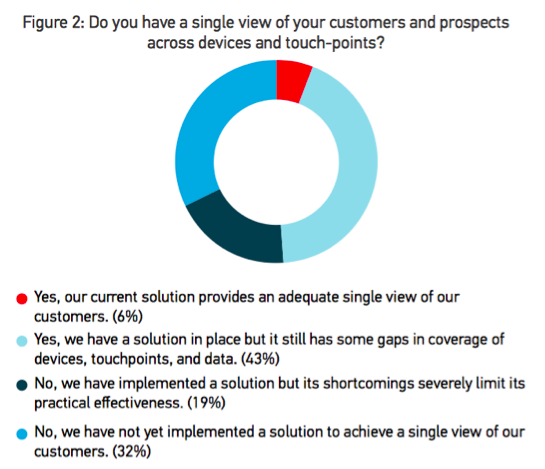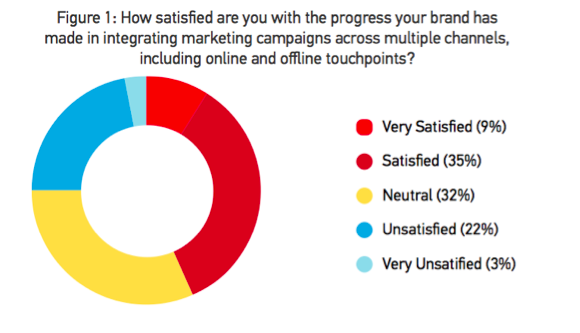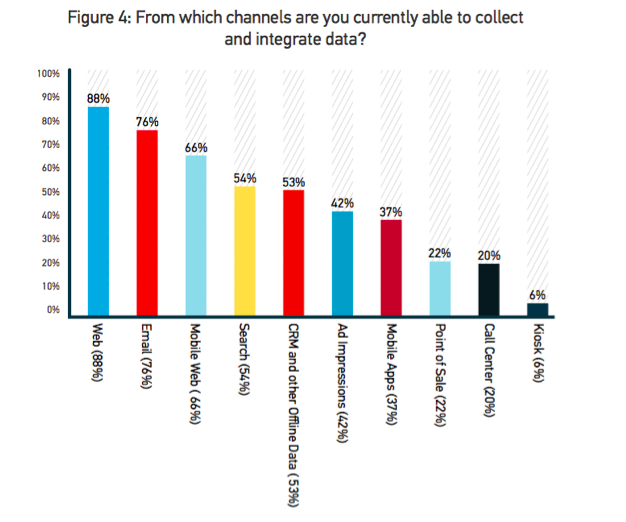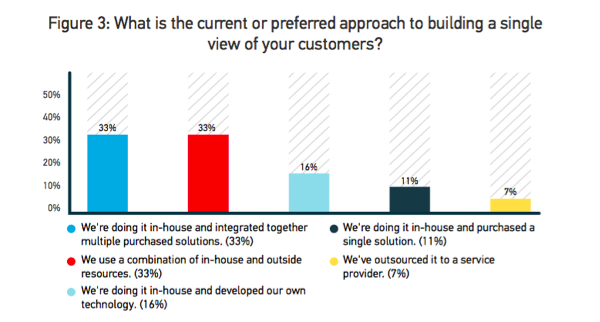Never before have marketers had so much data available to them about the habits of consumers. Never before though have they struggled so much to make connected and meaningful sense of this treasure trove of information. That’s the headline from a new report that takes a snapshot of today’s cross-channel, multi-screen marketing landscape. The goal? To provide insight into the steps marketers need to take to reveal a complete picture of their customers.
The Solving the Identity Puzzle report is the result of a study by marketing technology company Signal, who surveyed more than 170 brand and agency marketers earlier this year. This was a wide ranging group of professionals from the U.S., Europe, Asia, Latin America, and the Middle East, and across 18 verticals—predominantly retail (24 percent), marketing (20 percent), and technology (14 percent). The picture that emerges is that while the majority of marketers understand the vital importance of linking data about consumers from multiple sources in order to establish a single view of their needs, it also reveals that they are, for the most, part failing to make any real progress in doing so.
The Scale of the Problem
Life was once a lot simpler for marketers. In the early days of the digital revolution, their only touch-point with consumers tended to be in their physical stores, or on a customer’s desktop computer. This small amount of easily collected data, gathered either face-to-face or by way of third-party cookies, was, in the big scheme of things, a cinch to analyze and collate. Fast forward to the present and there is a deluge of data pouring in from multiple directions and from multiple devices, usually collected in separate departmental silos, silos that often do a poor job of communicating with each other.
The result? Few marketers feel they have conquered the cross-channel conundrum, nor are they satisfied with the results. And many times a factor to consider in this equation is that their internal IT teams either aren’t focusing on cross-channel integration and solutions and/or they don’t have the expertise to do so. That’s not a slam on IT teams, by the way, it’s just a reality. As marketing and tech become exponentially more complex, the skill sets needed also become exponentially more complex, and sometimes difficult to find. Are you finding that to be the case within your organization?
When it comes to cross-channel integration, six percent of survey respondents said they have a workable solution that gives a single view of their customer. More than half either have not yet implemented any solution, or, perhaps even worse when you consider the detrimental effects of dirty data, they have something in place that is severely limited.
As a result, just nine percent say that they are very satisfied with their integration while 57 percent indicate dissatisfaction or neutrality.
While web and email data appear to be most easily integrated, many marketers seem to struggle with other sources of data. There are some conspicuous gaps, particularly offline where just one in five of respondents said that they can integrate data from call centers and point of sale. What an opportunity missed to impress (and convert) customers as they toggle between offline and online contact with the company.
What surprises me the most, though, is that the biggest gap is with mobile, especially the mobile app, where just over a third say they are able to integrate data. I’ve said it before and I’ll say it again. We are moving toward a mobile dominated world and those who don’t understand this and get a strategy in place to maximize mobile in everything they do are going to have problems. This is where your IT team and/or a managed service provider with deep expertise in the mobile space (or both, working together) can have a huge impact on the bottom line.
It’s Not for Lack of Trying
It’s not as if marketers are unaware of the benefits of having a single customer view and haven’t been trying to do something about it. A clear majority of survey respondents said they want to move closer to a coordinated customer profile, with just one in ten of respondents taking a negative or neutral view on the subject. However, a massive 75 percent of those surveyed revealed they struggle with the basics of data collection. Nearly two-thirds (62 percent) say that marketing measurement is still incomplete, while the same proportion say that they are unable to personalize the customer experience in the way they would like, due to incomplete profiles.
Marketers are using a range of tactics to achieve a more coordinated approach, and the majority (almost 50 percent) are doing it in house, with purchased solutions and/or developing their own technology. Another 33 percent are doing some internally and outsourcing some, and 7 percent are outsourcing to a services provider. I think we’ll see those numbers continue to rise, especially at the rapid pace at which technology continues to change and require not only agility but the ability to innovate. It can often be much less of a hit on a budget to outsource some of the expertise you need at a high level–whether it’s for your content marketing solutions, lead gen, mobile solutions, or cross-channel IT expertise–than it is to try to hire FTEs with this depth of expertise.
The results here are disappointing, but not really surprising. The majority of survey respondents are making slow progress. Just eight percent said that they have a complete and effective set of capabilities, with almost two-thirds (62 percent) revealing they have gaps in capabilities. And while a third consider their coverage adequate, a shockingly high number—nearly a quarter of respondents—were either neutral or said they didn’t know what their cross-channel marketing capabilities even were! I’m pretty sure that if you don’t know what your capabilities are, you’re probably lacking in that department.
Here are some thoughts on what marketers and their IT counterparts can either work together to accomplish, or partner with a managed service provider to implement:
Creating a Single View
As the report authors state, a single customer view is the prerequisite to, and the foundation of, a cross-channel marketing strategy. So, how do we overcome the not inconsiderable challenges marketers face today? A pragmatic approach is suggested; one that breaks this seemingly impossible task down into smaller projects, creating momentum toward achieving long-term goals. Here’s how to do that:
Create a roadmap. The first step on the path is to define the goals, objectives, and analytics needed to execute the desired strategy, creating a roadmap of how these will be developed over time. Steps should be designed that are both achievable and measurable and that give added value at every stage. Start with smaller projects that will yield immediate value and show incremental ROI as the strategy moves forward.
Gather the right data. Collecting the wrong data from the right source or the right data from the wrong source is unlikely to be effective. The data requirements of the plan must be cross-referenced with the available data sources and data points so that the best information is collected in the right places at the right time.
Integrate the technology. If it were easy to buy an off-the-shelf solution to the single view problem, then more marketers would already be doing it successfully. Technologies tend to be diverse and often housed in silos in businesses of all sizes, particularly in larger organizations. The most effective tech solutions, both from in-house and external providers, need to be identified and built in an integrated manner to get the best out of available data sources.
Know when to get help. Don’t put mobile capabilities and/or cross-channel integration at the bottom of your to-do list. Move it right to the top. And consider augmenting your in-house expertise with what a managed service provider can bring to the table. Chances are good they can do it quicker, more cost-effectively, and deliver better results than if you try to tackle it on your own.
Benchmark, test and evaluate. Small steps along the road are fine, but unless you know you are still on track, you might drift off course, missing the long-term target. Benchmarking achievements, and then measuring performance by testing, evaluating, and learning from what works and what doesn’t is vital to progress.
The report concludes that the “stakes are high” for marketers and I wholeheartedly agree. The more complete a picture we have of customers and potential customers, the more we can satisfy their needs now and in the future. The data is there, the technologies are emerging, and the desire to tie it all together to create a single customer view is apparently there too. What is missing in many cases is a clear strategy to knock down departmental silos, open up lines of communication in-house, outsource when you need to, and create an integrated cross-channel environment.
Establishing a cross-channel identity for customers will be the gold standard for brands, advertisers, and marketers in the future. Getting there will be no easy task but however tough the challenge might seem, they all need to start taking at least small steps toward creating a single view of the customer. This study shows that many are still stuck at the starting line. Hopefully it will serve as a wake up call to get them moving in the right direction.
You can find a link to download the report at Solving the Identity Puzzle (registration required).
One final note, I wrote this post before I discovered IBM’s newest solution, called Journey Analytics, designed to help brands get a holistic view of their customers’ journeys and to connect marketing, e-commerce, and customer service. This isn’t an ad or an endorsement for the product, but if you’re interested in cross-channel marketing, it might be worthwhile for you to check out the Slideshare below, which gives an overview of the IBM product:
Additional Resources on this Topic:
Cross-Device Campaigns: The Focus of Smart Marketers Everywhere
Digital Marketing Integration: The Impact Of Cross-Channel And Content
Cross-channel Marketing in an Omnichannel World: No, it’s Not Impossible
This post was brought to you by IBM for MSPs and opinions are my own. To read more on this topic, visit IBM’s PivotPoint. Dedicated to providing valuable insight from industry thought leaders, PivotPoint offers expertise to help you develop, differentiate and scale your business.
Photo Credit: PresseBox.de flickr via Compfight cc
Originally seen on V3 Broadsuite Blog.
Shelly Kramer is a Principal Analyst and Founding Partner at Futurum Research. A serial entrepreneur with a technology centric focus, she has worked alongside some of the world’s largest brands to embrace disruption and spur innovation, understand and address the realities of the connected customer, and help navigate the process of digital transformation. She brings 20 years' experience as a brand strategist to her work at Futurum, and has deep experience helping global companies with marketing challenges, GTM strategies, messaging development, and driving strategy and digital transformation for B2B brands across multiple verticals. Shelly's coverage areas include Collaboration/CX/SaaS, platforms, ESG, and Cybersecurity, as well as topics and trends related to the Future of Work, the transformation of the workplace and how people and technology are driving that transformation. A transplanted New Yorker, she has learned to love life in the Midwest, and has firsthand experience that some of the most innovative minds and most successful companies in the world also happen to live in “flyover country.”





